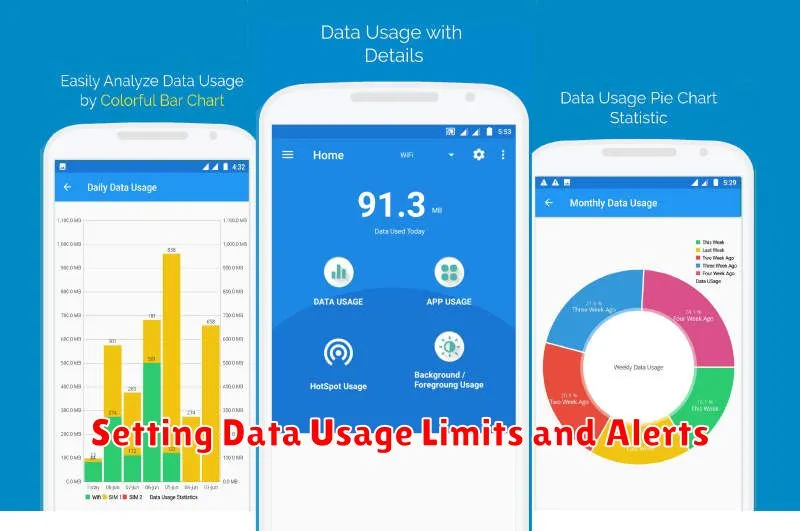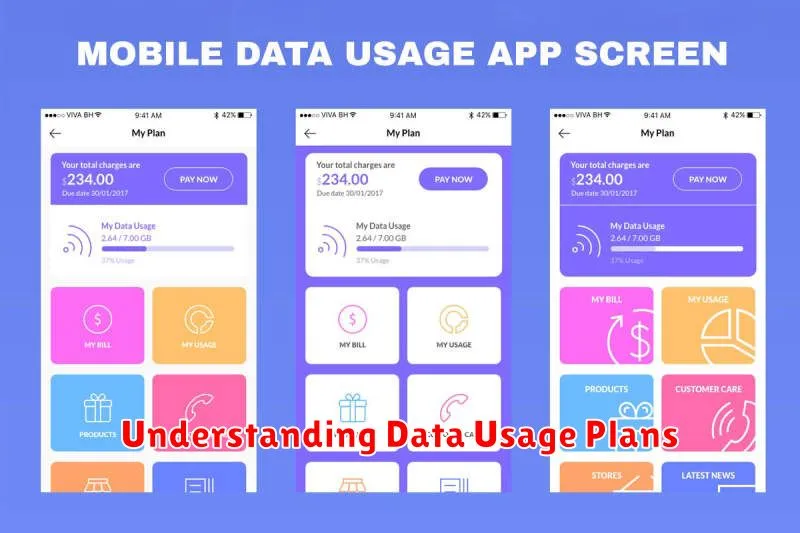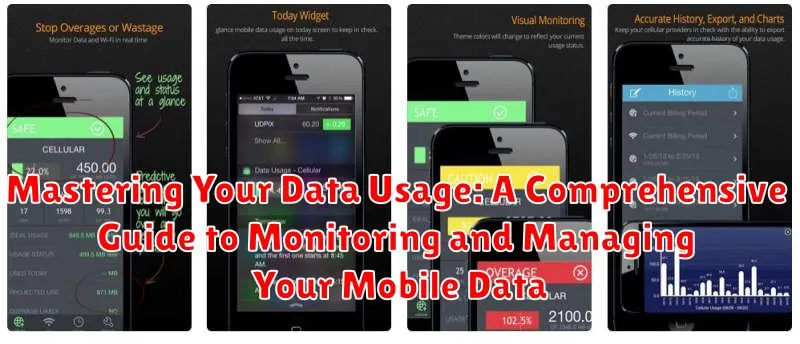In today’s interconnected world, mobile data has become an indispensable resource, powering our communication, entertainment, and access to information. Managing your data usage effectively is crucial, not only to avoid overage charges and maintain budget control, but also to ensure you have sufficient data when you need it most. This comprehensive guide will empower you to master your mobile data usage through effective monitoring and management techniques. Learn how to track your data consumption, identify data-hungry apps, and implement practical strategies to optimize your usage and stay within your data limits.
Whether you’re on a limited data plan or simply aiming to be more mindful of your consumption, understanding your mobile data usage patterns is the first step towards taking control. This article will provide you with the knowledge and tools necessary to monitor your data usage accurately, interpret your usage trends, and implement effective management strategies. From setting data usage alerts and utilizing built-in phone features to exploring third-party apps, you’ll discover a range of practical tips to master your mobile data and avoid unexpected bills. Gain valuable insights into optimizing your data usage for various activities such as streaming, browsing, and social media.
Understanding Data Usage on Your Phone
Your phone uses mobile data to connect to the internet when you’re not connected to Wi-Fi. This data fuels various activities, from browsing websites and checking social media to streaming videos and using location services. Understanding what contributes to your data usage is the first step toward effectively managing it.
Data-intensive activities like streaming high-definition videos and online gaming consume significant amounts of data. Less obvious data consumers include background app updates, cloud backups, and even seemingly small actions like loading images or sending messages with attachments. The frequency and duration of these activities directly impact your overall data usage.
Different apps and services consume varying amounts of data. For instance, music streaming generally uses less data than video streaming. Similarly, browsing text-heavy websites consumes less data than image-heavy ones.
Being aware of these different usage patterns will allow you to make informed decisions about your data consumption and avoid exceeding your data limit.
Methods for Checking Data Usage
Staying informed about your data consumption is crucial for effective management. There are several convenient methods to check your data usage, empowering you to stay within your limits and avoid unexpected overage charges.
Built-in Phone Settings
Most smartphones offer a built-in data usage tracker within the settings menu. This feature typically provides a detailed breakdown of data usage per app, allowing you to pinpoint data-hungry applications. It often visually represents your usage against your data cycle, offering a clear picture of your current consumption.
Carrier Apps and Websites
Wireless carriers often provide dedicated apps or websites that allow subscribers to monitor data usage in real-time. These platforms often provide detailed reports and usage history. Some even offer tools for setting data limits and alerts directly through their services.
USSD Codes
Using USSD codes is a quick way to check data balance. These codes, specific to each carrier, can be dialed directly from your phone’s dialer. While generally providing less detail than in-app or website methods, they offer a convenient way to quickly check your remaining data.
Tips for Reducing Data Consumption
Managing your mobile data effectively involves implementing strategies to minimize consumption. Restricting background data usage for specific apps prevents them from consuming data when not actively in use. You can configure these settings within your device’s app management options.
Utilizing Wi-Fi networks whenever available is another crucial step. Ensure your device is configured to automatically connect to known Wi-Fi networks. This significantly reduces reliance on mobile data, especially for data-intensive tasks like streaming and downloading.
Compressing data usage within your browser can also contribute to savings. Most modern browsers offer data compression options, which reduce the size of web pages before they load, resulting in lower data consumption.
Updating apps only over Wi-Fi is a good practice to avoid large downloads consuming your mobile data allowance. Configure your app store settings to prevent automatic updates over cellular connections.
Setting Data Usage Limits and Alerts

Proactively managing your mobile data involves setting usage limits and alerts. This feature, typically available within your phone’s settings, allows you to define a threshold for data consumption within a given billing cycle. Once this limit is approached or reached, you’ll receive a notification, preventing unexpected overage charges.
Most devices offer customizable alert levels. You might set a warning alert when you’ve used 75% of your data, and a hard limit at 90%, effectively restricting further data usage until the next billing cycle. These settings offer granular control, helping you stay within your allotted data plan.
Setting Data Limits:
- Open your phone’s settings.
- Locate the “Network & internet” or “Connections” section (naming may vary based on your device).
- Select “Data usage” or “Mobile data usage.”
- Look for the option to set a data limit or warning.
- Input your desired limits based on your plan.
Remember to configure these limits according to your individual data plan and typical usage patterns for optimal effectiveness.
Data Management Apps and Tools
Several apps and tools can provide more granular control over your data usage, supplementing the built-in features of your device. These apps often offer advanced features for monitoring, analyzing, and controlling your data consumption.
Data monitoring apps can provide real-time tracking of your data usage, breaking down consumption by app and even showing you the rate at which data is being used. Some apps offer customizable alerts and notifications to warn you when you approach your data limit or exceed a specified threshold.
Firewall apps give you control over which apps can access the internet via cellular data. This can be particularly useful for preventing background data usage by apps you don’t use frequently. Some firewall apps also offer ad-blocking capabilities, further reducing data consumption.
Data compression apps use various techniques to reduce the amount of data transmitted over your cellular connection. They work by compressing data before it reaches your phone, resulting in lower data usage overall. However, it is important to note that these apps may impact the performance of some apps and services.
Understanding Data Usage Plans

Data usage plans are the foundation of your mobile internet experience. Understanding them is crucial to avoid overage charges and ensure you have enough data to meet your needs. These plans define how much data you can use each billing cycle for activities like browsing, streaming, and downloading.
Most plans fall into tiered categories. These range from limited data plans suitable for light users to unlimited data plans ideal for heavy data consumers. A limited data plan provides a fixed data allowance, after which your speed may be reduced (throttled) or you may incur extra charges. Unlimited plans offer a specific amount of high-speed data, after which speeds may be reduced, but you typically avoid extra charges.
Key factors to consider when choosing a plan include your typical usage, budget, and the availability of different plan types from your provider. Be sure to review the details of each plan, focusing on data limits, throttling thresholds, and any overage fees.
Troubleshooting Data Usage Discrepancies
Discrepancies between your perceived data usage and your carrier’s reported usage can be frustrating. Here’s a breakdown of common causes and troubleshooting steps:
Common Causes
- Background App Activity: Apps often refresh and update data in the background, even when you’re not actively using them. Review your app permissions and restrict background data for non-essential apps.
- Software Updates: System and app updates can consume significant data. Connect to Wi-Fi before downloading updates.
- Streaming Services: High-definition video and music streaming quickly deplete data. Monitor your streaming habits and adjust quality settings as needed.
- Tethering: Sharing your mobile data connection with other devices dramatically increases data usage. Keep track of connected devices and limit tethering time.
Troubleshooting Steps
- Restart Your Device: A simple restart can sometimes resolve temporary software glitches affecting data tracking.
- Check Data Usage Settings: Verify the dates on your device and carrier’s data usage reports to ensure they align.
- Contact Your Carrier: If you suspect a billing error or technical issue, contact your carrier’s customer support for assistance.

